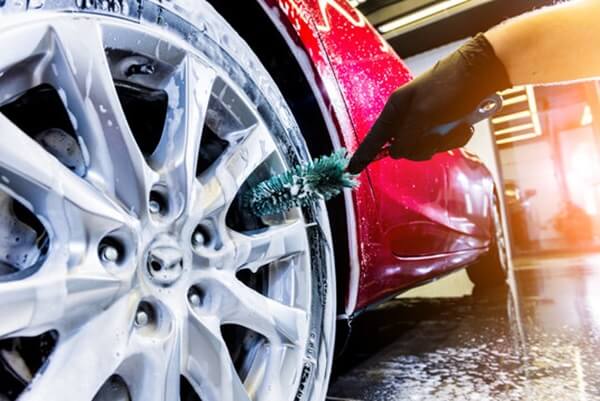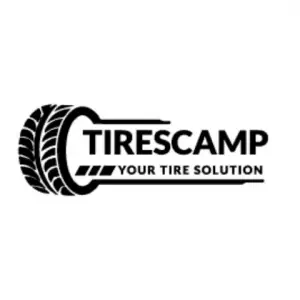New tires almost universally have white brand lettering on the sidewall. Most of these tires have blue paint over them to prevent oil and dirt from getting on the white writing while the tires are being mounted on a car for the first time. The blue paint seems out of place, but it can be removed with a little effort and the right materials.
Materials Required to Clean the Blue Off New Tires
- Car wash soap
- Scrubbing brush
- Hot water
Steps Involved in Cleaning the Blue Off New Tires
Step 1: Directly apply the car Wash soap to the part of the tires with the blue paint
Avoid diluting the car wash soap in a bucket with water. Rub the soap all over the painted surface with full power.
Even though dish soap shouldn’t be used on your automobile, it can be used on the tires. Dish soap dissolves the wax on painted surfaces, leaving them exposed to air and drying out.
Step 2: Scrub off the blue paint with a brush
You may scrub vigorously to remove the paint because the tires won’t be harmed, but if you scrub too hard in one spot, the white brand letters will also start to peel off.
Step 3: Rinse the tires with hot water
To monitor your progress, regularly rinse the tire with hot water. Scrub the tire vigorously till all the blue paint is off the tire.

Tips for Maintaining Your New Tires
Learn to Read Your Car’s Tires
Understanding the numbers on the sidewall of your tire is the first step in proper tire care. Most tires have 12 letters and digits on the side corresponding to the tire’s construction, size, load index, diameter, and speed rating. Your tires might only be rated 100 mph, but your car can reach 155 mph.
Verify Tire Pressure
Another thing that will ensure that your tires retain their new look is maintaining the correct pressure. It’s wise to purchase a traditional tire pressure gauge to carry in your vehicle. This will ensure that you can regularly check the tire pressure when needed.
Check for Wear and Tear
This process is fairly easy. You only need to look at the vehicle’s tires and check for sidewall bubbles, fractures, scrapes, or gouges. Some indicate that the tires are getting old, while others indicate that the tires are damaged. In either case, you should change them.
Complete Tire Rotations
You might be able to obtain a tire rotation at no cost, depending on where you buy your new tires. If not, you should adhere to the instructions provided in your owner’s manual or the tire manufacturer’s regarding how often and in which direction to rotate the tires. Tire rotations must typically be done every 5,000 miles to 10,000 miles.
Use the Proper Tires
Once you learn how to read your tires’ sides, finding the proper tire is as simple as it seems. However, choosing the correct tires also heavily depends on where you stay and your driving habits.
If your automobile is mostly used for commuting, you should look for tires that can withstand long highway drives. If you drive a sports car and love racing on your favorite winding route, be aware that your tires will wear faster and sticky tires will cost you more.
Do you have to endure cold and snowy weather? Think about getting a set of winter-specific tires.
Clean the sidewalls
It’s simple to maintain your tires by cleaning them. An excellent way to keep your tires safeguarded from everything they come into direct contact with is to apply a high-quality tire shine frequently.
A proper tire shine can maintain your tires in good condition and looking good despite dirt, gravel, and the sun.
Pay Attention to the Tread Depth
Your tire’s tread depth measures the amount of rubber in contact with the ground. The typical tread depth of new tires is between 10/32 and 11/32 inches.
Your tire tread will deteriorate while you drive. States with safety checks have tread legal minimum limits.
You can measure your tires with a tread depth gauge or a penny. In most states, the tread depth limit is 2/32 of an inch. Anything less than that tread is a life-threatening gamble.
Avoid Overloading Your Vehicle
Your vehicle’s tires experience increased pressure when it is overloaded. You can maintain your tires by limiting your load to what they can handle.
Know What’s Inside Your Tires
Your tires’ green tire caps are a positive sign that nitrogen is present inside them. You can fill a tire with air even if you have nitrogen. But, if your tire is nearly flat or requires a lot of air, look for a location with nitrogen.
Don’t Overlook Tire Rating or TPMS Light
Both your TPMS light and the numbers on the tires are very important. The numbers have a lot of significance, and you must respect them—from the weight capacity the tires can support to the greatest speed you may safely go.
Additionally, you must respect the TPMS light on your car. When the light turns on, you must check your tires to see if they are underinflated or overinflated. Ignoring a TPMS light can significantly impact how your vehicle handles, utilizes gasoline, and performs.
Replace Your Tires as Needed
Tires are the sole thing keeping your car on the road, despite being pricey. Don’t put off changing your tires when the time comes. And make sure you purchase the appropriate tires for your car and driving style.
Frequently Asked Questions (FAQ)
Why Does Brand-New Tire Turn Blue?
Numerous oils are utilized in the manufacture of tires, and the blue coloring indicates that the rubber has been overworked and the oils are rising to the surface.
Why Do Tires Turn Brown?
Organic antiozonant is utilized in tires and helps extend tire life by reducing oxidation-related degradation. Antiozonant gradually works its way to the outer edge of the rubber casing, causing car tires to bloom. The compound produces a brown deposit on the tire’s surface as it reacts with oxygen.
Can You Put Air in Tires with Nitrogen?
It is entirely safe to fill nitrogen-filled tires with ordinary compressed air if there is no other way to refill them. To preserve the advantages nitrogen tires offer, you will eventually need to purge the tire and fill it with nitrogen.
How do you clean residue off new tires?
Take Bristle brush, Scrub the tire warm water ad dish soap, take 1 tablespoon of soap per gallon water. Then mix all properly. Now you can clean as you wish.
Final Take
Most tires have blue paint to prevent oil and dirt from getting on the white writing, while the tires are mounted on a car for the first time. After reading this article, we hope you can now clean the blue off new tires.
